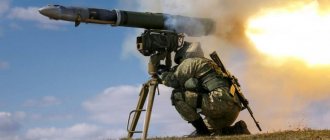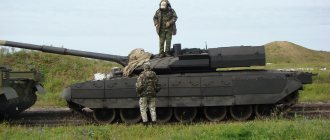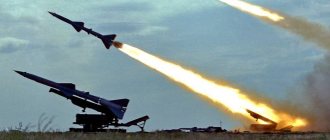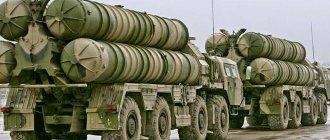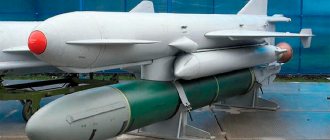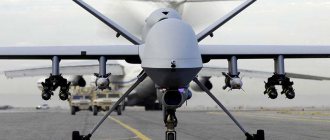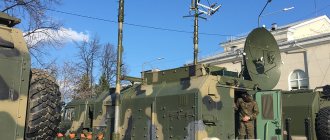The armored vehicles of Russia and the world, photos, videos, watch online, were significantly different from all their predecessors. To provide a large reserve of buoyancy, the height of the hull was noticeably increased, and to improve stability, its cross section was given a trapezoidal shape. The required bullet resistance to the hull was provided by rolled cemented armor with an additionally hardened outer layer of the KO brand (“Kulebaki-OGPU”). In the manufacture of the hull, armor plates were welded on the inner soft side, and special stocks were used to facilitate assembly. To simplify the installation of units, the upper armor plates of the hull were made removable with a seal on fabric gaskets lubricated with red lead.
Armored vehicles of the Second World War in which the crew of two people was located near the longitudinal axis at the back of each other's heads, but the turret with weapons was shifted 250 mm to the left side. The power unit is shifted to the starboard side in such a way that access for engine repairs was possible from inside the tank's fighting compartment after removing the safety partition. At the rear of the tank, along the sides, there were two gas tanks with a capacity of 100 liters each, and directly behind the engine there was a radiator and a heat exchanger, washed by sea water when moving afloat. At the stern, in a special niche, there was a propeller with navigable rudders. The balance of the tank was chosen in such a way that when afloat it had a slight trim to the stern. The propeller was driven by a cardan shaft from a power take-off mounted on the gearbox housing.
Armored vehicles of the USSR in January 1938, at the request of the head of the ABTU D. Pavlov, the tank’s armament was to be strengthened by installing a 45-mm semi-automatic gun or a 37-mm automatic gun, and in the case of installing a semi-automatic gun, the crew was to be increased to three people. The tank's ammunition was supposed to consist of 61 rounds for the 45 mm cannon and 1,300 rounds for the machine gun. Design Bureau of Plant No. 185 completed two projects on the “Castle” theme, the prototype of which was the Swedish Landsverk-30 tank.
The Wehrmacht armored vehicles did not escape troubles with engine boost. To what has been said, we can only add that this crisis was actually overcome only in 1938, for which the tank received not only a forced engine. To strengthen the suspension, thicker leaf springs were used. Rubber tires made of neoprene, a domestic synthetic rubber, were introduced, the production of tracks from Hartfield steel by hot stamping began, and high-frequency-hardened fingers were introduced. But all these changes to the tank were not introduced simultaneously. The tank hull with inclined armor plates could not be manufactured on time. However, the conical turret with improved protection was submitted on time, and the tank with the same hull, reinforced suspension (due to the installation of thicker leaf springs), a forced engine and a new turret entered testing at the NIBT test site.
Modern armored vehicles went under the code T-51. It retained the process of transition from tracks to wheels, like the prototype, by lowering special levers with wheels without a person leaving. However, after adjusting the requirements for the tank, making it a three-seater (it was decided to retain backup control for the loader), and strengthening its armament to the BT level, it was no longer possible to implement the Landsverk-type wheel drive. In addition, the tank's wheel drive transmission was overly complex. Therefore, soon work on the “Castle” theme was carried out on the T-116 tank, in which “change of shoes” was carried out according to the BT type - by removing the track chains.
Computer, card, solution
This stereotype has developed over decades: the commander of a company, battalion, or even regiment leads the battle, and at the same time there is always a signalman with a portable radio station nearby. What has changed today? At the tactical level, modern command and staff vehicles now play the first fiddle in ensuring control of combat operations. Yes, they have been used before, but the current filling, and therefore the possibilities, have increased dramatically. This fully applies to the unified command and staff vehicle R-149MA1. This equipment has been actively supplied to the troops in recent years.
In essence, this is an advanced mobile command post, developed as part of the implementation of the decree of the President of the Russian Federation on the creation of a unified tactical level command and control system (USUTZ) in the Russian Armed Forces.
The equipment of the R-149MA1 command and staff vehicle allows you to quickly monitor changes in the military situation on electronic terrain maps while stationary and on the move, taking into account the actions of friendly units and enemy forces. With its help, you can make the necessary calculations and assign tasks to your subordinates in the shortest possible time.
The main unit of use is the battalion, but as part of a complex unified control system at the tactical level, this command and staff vehicle interacts with communications equipment of higher command levels - regiment, brigade, and lower ones - company, platoon.
What are the main advantages of the R-149MA1 unified command and staff vehicle? Despite the four-axle base chassis from the BTR-80, the usual armament for an armored personnel carrier is absent - management functions are a priority. Therefore, the internal “filling” is given over to various equipment. Thus, it takes no more than a minute to determine your own location and the location of the vehicles of subordinate units. This problem is solved in real time by the Azimuth navigation equipment with a navigation reference accuracy of 30 meters.
© dishmodels.ru R-149MA1.
The “Brain Center” is a high-power on-board computer that allows you to process incoming information and immediately display it on an interactive screen. The commander has the opportunity to assess the situation, make a decision and convey it to subordinate units.
The R-149MA1 crew is able to quickly deploy integrated networks to provide communications at the tactical and operational levels. According to the standard, no more than ten minutes are allotted for deployment and communication while moving, and no more than half an hour when stationary.
The operation of the crankshaft is maintained in the temperature range from -40°C to +50°C. Calculation - 6 people with four automated workstations.
The R-149MA1 unified command and staff vehicle is equipped with ultrashort wave radio stations: R-168-100UE-2, R-168-5UNE-2, R-168-0.1U(M)1E, “Prima-DMV”. Plus two shortwave radio stations R-168-100KBE and Prima-KV.
These means make it possible to provide operational command communications in the VHF range while on the move - up to 25 km, and when stationary - up to 55 km. If you need to “get” further away, then HF radio stations are used: when moving, the range is 50 km, and when stationary using a mast - up to 350 km. This ensures the reception/transmission of classified data via cable and VHF/HF radio channels using data and speech encryption equipment.
The use of the unified command and staff vehicle R-149MA1 as a component of an automated troop control system at the tactical level, compared to previously existing ones (without automation), reduces the cycle of troop and weapon control by three times, and the relevance of information on the enemy increases by 5 times. In general, it takes no more than 10 minutes to collect data and plot it on a map, and up to 5 minutes to assign combat missions to subordinate commanders.
... Of course, all these wonderful characteristics and capabilities are impressive, but what about the enemy’s electronic countermeasures? Will it happen that the R-149MA1 command and control vehicle will become blind, deaf and dumb? Nothing like this! There is just one more advantage here: this command and staff vehicle has increased noise immunity and “imitation resistance,” that is, the ability to withstand active attacks from the enemy in order to impose a false message or replace a transmitted one, change stored data.
In other words, signalmen will not lose in a confrontation with enemy electronic warfare systems, which has been proven more than once during important exercises.
Complexes RB-636 “Svet-KU” / R-330Zh “Zhitel” / R-149AKSh-1 / R-419L1 - photo review
The fourth part of a photo review of the exhibition of the latest weapons and military equipment , held on June 30, 2022 in the capital of the Republic of Mordovia - the city of Saransk. The equipment arrived from Engels Air Base to cover the city airport during the World Cup matches, and before being sent back, it took part in a one-day exhibition.
Below is a photo review of the following samples of communication, control and electronic warfare vehicles: radio and electronic intelligence complex RB-636 “Svet-KU”; automatic radio jamming station R-330Zh “Zhitel”; R-149AKSh-1 command and staff vehicle; mobile digital radio relay station R-419L1.
| Radio and electronic reconnaissance complex RB-636 “Svet-KU” | |
| The RB-636 mobile complex for radio and electronic monitoring and protection of information from leakage via technical wireless communication channels was put into service in 2012, developed by STC LLC. Designed to assess the electromagnetic situation, search, detect and expressly analyze radio emissions, as well as determine the location of their sources in the VHF and UHF ranges, when working together with similar stationary and mobile technical control and electronic reconnaissance complexes. | |
| Automatic radio jamming station R-330Zh “Zhitel” | |
| The R-330Zh automated jamming station was put into service on January 21, 2008, and is used as part of the R-330M1P “Diabazol” automated jamming system. The station provides: 1 - automated detection, direction finding and analysis of signals from radio emission sources in the operating frequency range; 2 - causing radio interference to portable and mobile ground stations (user terminals) of the INMARSAT and IRIDIUM satellite communication systems, navigation equipment of consumers of the NAVSTAR satellite radio navigation system (GPS) and base stations of the GSM-900/1800 cellular communication system; 3 - automated telecode information exchange with a similar conjugate ASP to ensure synchronous direction finding of radio emission sources for the purpose of calculating their coordinates; 4 - automated telecode information exchange with a higher control point in order to receive a task for conducting combat work and a report on the results of the work; 5 — automatic testing of equipment and identification of faulty elements (components); 6 - maintaining cartographic data with displaying information about explored sources of radio emissions against the background of an electronic topographic map of the area or in a grid of rectangular coordinates. | |
| Command and staff vehicle R-149AKSh-1 | |
| Command and staff vehicle R-149AKSh-1 manufactured by JSC Elektroavtomatika. Designed to provide control of military units and subunits of branches of the RF Armed Forces, branches of the RF Armed Forces and logistics units of the RF Armed Forces in difficult operating conditions and in conditions of deliberate interference in radio networks and radio directions in automated and non-automated modes. | |
| Mobile digital radio relay station R-419L1 | |
| The radio relay station R-419 L1 is designed for organizing independent radio relay communication lines, as well as for branching channels from multi-channel radio relay, tropospheric and wire communication lines. The station provides operation on anchor lines via 6 channels of HF equipment P-330-6 with the ability to re-receive via HF channels of P-340 GMN equipment on communication lines up to 120 km long in the range of 390-645 MHz, and in digital modes on communication lines up to 400 km in the range 390-645 MHz and up to 1500 km in the range 1550-1850 MHz. | |
| Specification plates | |||
Photo © Leonid Karyakin, 06/30/2018
To be continued
Join our group “Courage 2004”
Share on social networks:
R-149 BMR "Kushetka-B"
R-149BMR “Kushetka-B” on the BTR-80 transport base
KShM R-149BMR “Kushetka-B” is designed to provide command and control of troops and organize communications at the operational-tactical command and control level while on the move, afloat and stationary, both autonomously and as part of a communications center. The KShM is equipped with radio stations (“Berkut-M”, R-171M, R-173M, R-163-50U, R-163-10V, R-163-1V), internal communication and switching equipment, as well as equipment for confidential information transmission and telephone connection.
KShM provides: – simplex radio communication in the short-wave (HF) and ultra-short-wave (VHF) frequency range; – radiotelephone communication from the crew workstations, remote telephone subscriber and driver via radio station R-163-50U; – radiotelephone communication using confidential communication equipment from the crew’s workplaces (except for the driver-electrician) and the subscriber of a remote telephone set; – transmission and reception of information via telephone, pulse and telegraph channels of confidential communication equipment; – telegraph communication via radio station “Berkut-M”; – reception and transmission of circular and selective calls via radio stations; – internal circular, selective and conference communication between crew members; – official communication with the operator of an external radio station and communication center; – manual retransmission between any two radio stations; – automatic retransmission using confidential communication equipment between two radio stations; – remote control of the installation of the HRF of the radio stations “Berkut-M”, R-171M, R-163-50U and the modes of the radio station “Berkut-M”.
Frequency range, MHz 1.5-30; 30-76; 80-120 Communication range, km (depending on antenna type) 5-350.0 Nominal onboard voltage, V 22-30.0 Travel speed, km/h: – on the highway 80.0 – afloat 9.0 Overall dimensions , mm 7700x2900x2630 Power sources: – armored personnel carrier network; – battery 12ST-85R (in emergency mode); – electric machine converter PEM-4-28.5 (from an industrial network with a voltage of 380V, a frequency of 50Hz); – electric unit AB-1-P28, 5-B-V1 Antennas: – 2m, 3m and 4m pin; – symmetrical vibrator; – disc-cone broadband; – wide-range; – pin anti-aircraft radiation.
Transport base for other modifications: UNSh K1Sh1, modifications to MT-LBu, BMP-1, BTR-80, GAZ-66 (Ural 43203). R-149BMR “Kushetka-B” another version The R-149 BMR (KShM) command and staff vehicle, located on a wheeled floating armored personnel carrier, is designed to provide communications for the tactical control level. Year of development: 1995.
The product provides: simplex and duplex radio communication in the HF and VHF frequency range; conducting telephone conversations in open and confidential modes, transmitting data through all communication channels formed by the communication means of the product and channels represented by means of the communication center, while stationary and on the move; reception and transmission of circular and selective calling signals on all radio stations; automated information exchange using a PC; television overview of the area, reception and transmission of video images in “freeze-frame” mode via communication channels; reception, storage and transmission of telecode information in circular and selective modes; determining the coordinates of the product location using navigation equipment operating in the GLONASS, NAVSTAR systems, displaying them on an electronic map of the area (on a PC screen) and transmitting them via communication channels; conducting open and confidential telephone conversations and automated exchange of information from an official’s workplace located at a distance of up to 100 m;
Main characteristics Crew, persons. 3 Number of officers’ jobs 3 Operating frequency range, MHz – HF 1.5…29.999; – VHF 30…119.995 Communication range: – in motion: – in the HF range, 300 km – in the VHF range, 60 km Power supply: – from the on-board 27V network is provided by: – from the GOM of the transport base – from an external 3-phase network 380V/ 50Hz – from the built-in electrical unit AD-3.5U-28.5
KShM equipment HF radio station R-168-100KA 1 piece; VHF radio station R-168-100U 1 piece; VHF radio station R-168-25U 1 piece; VHF radio station R-163-10V 1 piece; Portable VHF radio station R-163-1V 1 piece; Confidential communication and data transmission equipment 1 piece; Internal communication and switching equipment (AVSK) 1kt.; Personal computer in an agreed version 2 pcs.; Video surveillance equipment P-338 1 piece; Navigation equipment SN-3001 1 piece; Antenna-feeder system: - antennas ASh-4 “Symmetrical vibrator”; AZI, ShDA-50 - AFS switching and control equipment 1 piece; Life support systems (OV-65, FVU, ventilation, lamp) Auxiliary equipment and spare parts 1 set; It is possible to install additionally: – satellite communication station R-438 – station for communication with aviation R-853B2
Modifications:
R-149BMRA
Equipment composition: R-171M R-163-50U R-163-10V R-163-1V – remote kit R-134M R-862 2 pcs.
R-853 – remote kit R-012M T-230-1A T-240D 2 pcs. – 1 device belongs to the remote set T-235-1U TA 2 pcs. – remote set P-274M 1 km. – remote set of PC SCh-4 “Cheln” AP communication and switching AFS Power unit. R-149BMRG Equipment composition: R-171M 2 pcs. R-163-50U R-163-10V R-163-1V – remote kit R-438 – place for installing R-134M R-853 – remote kit R-012M T-230-1A T-240D 2 pcs. – 1 device belongs to the remote set T-235-1U TA 2 pcs. – remote set P-274M 1 km. – remote PC kit ZK-TA SCh-4 “Cheln” AP communication and switching AFS Power unit. R-149BMRD
The R-149BMRD command and staff vehicle is designed to accommodate officials at workplaces and provide them with control in various operational and tactical conditions.
The product is designed to organize control and communication via wired and radio communication channels, and provides the ability to work with data transmission equipment (DAE), compression equipment, and a satellite communication station (SCS). The product provides round-the-clock operation in a parking lot and on the move, both autonomously and as part of a communication center. Composition: Radio station R-168-100UE – 2 sets; Radio station R-168-100KB – 1 set; Product T-231-2A-5 – 2 sets; Internal communication, switching and control equipment (AVSKU) – 1 set; Power supply device (UP-2) 1 set; Radio station R-168-5UNE – 1 set; Product T-231-1N – 1 set; Equipment T-236-V – 1 set; KSUD – 2 units; USD – 1 set; Workstation “Baguette-RS6” – 3 sets. Power sources: – external four-wire three-phase alternating current network with a voltage of 380V and a frequency of 50Hz; – diesel electric unit AD-2.0U-P/28.5-S; – generator of the on-board network of the transport base with a voltage of 27V; – 24V batteries – (in emergency operating modes of the power supply system). The power consumed by the hardware room from the AC network is no more than 4000W. Equipment room weight – no more than 8200 kg R-149MA1
The unified command and staff vehicle R-149MA1 is designed to provide control and communication to brigade-regimental level TZU officials while stationary and on the move. KShM can also be used at the operational level when used by officials at forward control posts. Manufacturer – Tambov plant “October” Base – BTR-80 (K1Sh1 body)
Crew (persons) 6 Number of automated workstations (AWS) 4 Number of radio channels for operational command communication: – HF range 1 simplex – VHF range 4 simplex – Service communications 2 simplex Communication range, operational command communication (km): – VHF radio stations in in motion up to 25 – VHF radio stations in the parking lot up to 55 – HF radio stations in motion up to 20 – HF radio stations in the parking lot up to 350 – Service communications up to 1.2 Navigation reference accuracy (m) 30 Transport base K1Sh1 Weight (kg) 15,000 Deployment time for work in motion/parked (min) 10/30 Operating ambient temperature (degrees) -40/+55
KShM provides: Formation of up to 4 simplex and 2 duplex VHF radio channels using R-168-100UE radio stations: – when working on the R-168BShDA antenna – when stationary and in motion – when working on the R-168ShDAM antenna – in the parking lot Formation of a simplex HF radio channel using radio stations R-168KBE: – when working on the ASh-4 antenna – in a parking lot and on the move – when working on a “dipole” antenna – in a parking lot Establishment of a simplex high-speed VHF radio channel using the radio station R-168МRAE Rchevaya communication using two portable radio stations R-168-0.1UME when stationary and on the move Reception and transmission of data via VHF and HF radio channels Reception and transmission of data via cable Reception and transmission of speech via VHF and HF radio channels Reception and transmission of speech via cable Reception and speech transmission from a remote workstation via a VHF radio channel Automatic determination of the coordinates of your location using the Azimuth product, entering coordinates and time stamps into the computer Internal service communication using the AVSKU-E complex: – conference calling from all workstations equipped with control panels – circular communication from all workstations equipped with control panels – selective communication between all workstations equipped with control panels. – loudspeaker communication via a loudspeaker unit from the vehicle commander’s workplace; Azimuth products – computer [email protected] 7020T (4 pcs) – radio stations R-168-100KBE – radio stations R-168-100UE – radio stations R-168MRAE – equipment T-237E – information documentation devices UD-M111D Using automated workstations officials of the operational staff, the product provides the following basic functions: - receiving, processing and displaying orders and signals from combat control - generating and issuing orders from combat control - collecting and processing reports on the receipt and reports on the execution of orders from combat control - collecting information on operational-tactical situation, its processing, storage, documentation and display - collection, processing, storage and display of information about combat and numerical strength - collection, processing, storage and display of information about enemy troops - collection, processing, storage and display of information about the conditions of combat operations and data for assessing the operational-tactical situation - generation, storage, search, processing, archiving and documentation of combat documents - solving special calculation problems - generation, processing and display of navigation data, tracking the position of moving objects using carriages - use of electronic terrain maps of various scales for of a given combat area - drawing the operational-tactical situation on electronic maps with the possibility of transmitting it via communication channels. Continuous round-the-clock operation with breaks for maintenance Reception and transmission of classified data via VHF and HF radio channels using the T-237E product Reception and transmission of data via cable using the T-237E product Reception and transmission of classified speech via VHF and HF radio channels using E- products 11C Reception and transmission of classified speech via cable using E-11C products Reception and transmission of classified speech from a remote workstation using the R-168-5UNE radio station and E-11N product at a distance of at least 1,000 m.
R-149MA3
Unified command vehicle Based on the BTR-80-M. Manufacturer – Tambov plant “October”
Secondary field communication nodes
Federal State Budgetary Educational Institution of Higher Education “Ivanovo State Energy University named after V.I. Lenin" APPARATUSNEEFIELD COMMUNICATION CENTERSTutorial
Ivanovo
2018
Hardware of field communication nodes.
Textbook allowance / Ed. V. G. Belonogova – Ivanovo.: ISEU, 2018. – 169 p.
The textbook is intended for students enrolled in the military training program at ISUE; it can also be used during the professional training of officers - military training teachers. The content of the material in the textbook allows students to comprehensively study the composition and capabilities of the communication center hardware studied during military training, and to organize the competent operation of control center communication centers.
The team of authors has developed a separate collection for the textbook - an album of structural and functional diagrams and cable entries of equipment rooms and stations.
The textbook was developed by a team of authors: D.V. Korolev, A.K. Golubev, V.E. Gerasev, R.V. Gavrilov, S.V. Rutsyn. Table of contents
| Main abbreviations…………………………………………………………….. | 3 | |
| Introduction…..………………………………………………………..………………… | 7 | |
| 1. | Hardware controls and command and control vehicles... | 8 |
| 1.1. | Command and staff vehicle R-149AKSh1 ……………………………… | 8 |
| 1.3. | Command and staff vehicle R-149MA1…………………………… | 12 |
| 1.3. | Command and staff vehicle R-142T(TO) ……………………..….. | 16 |
| 2. | Complex hardware communications…………………..……….… | 20 |
| 2.1. | Hardware room P-260-O………….……………………….………..…. | 20 |
| 2.2. | Hardware room P-260-U…………………………….…………..…. | 24 |
| 2.3. | Hardware P-260-T….…………………………….…………..…. | 31 |
| 2.4. | Complex hardware communication MP-1IM..…………………………. | 35 |
| 2.5. | Integrated communication hardware MP-2IM………………..………. | 41 |
| 2.6. | Mobile set of secure video conferencing…….. | 47 |
| 3. | Hardware and channelization stations…………..……… | 52 |
| 3.1. | Digital channelization hardware P-266K……………… | 52 |
| 3.2. | Radio relay station R-419L1 ..….….………………..……….. | 66 |
| 3.3. | Digital radio relay station R-416GM ……………..……… | 75 |
| 3.4. | Antenna module R-431AM..…..…..…..………………………….. | 82 |
| 3.5. | Digital tropospheric station R-423AM..…………..………… | 88 |
| 3.6. | Digital tropospheric small-sized station R-423PM…… | 100 |
| 3.7. | Satellite communication station R-441-OV..…………………………… | 102 |
| 3.8. | Mobile satellite communication station R-439MD2……..……… | 107 |
| 3.9. | Satellite communication station R-444-D……………………..……… | 109 |
| 3.10. | Satellite communication station R-439-MD3-KR………………..…… | 112 |
| 3.11. | Satellite communication station R-444-PTN…………………..…… | 116 |
| 4. | Power supply stations.….……………………..………..… | 117 |
| 4.1. | Electrical unit AD-4-P/28.5-1VM1…………………………….. | 117 |
| 4.2. | Electrical unit AD-4-T/400-VM2 (AD-6-T/400-VM2)……..……. | 118 |
| 4.3. | Power plant ED-2x16t/400……………………………………………………… | 120 |
| 4.4. | Power plant ED 230-T/400 3RA (“Luggage”)……………..……. | 121 |
| 4.5. | Power plant ED 230-T/400 1RAM1…………..……………… | 125 |
| 4.6. | Power plant ED-230-T/400 1VAS……………..…………….. | 127 |
| 5. | Purpose and capabilities of the main equipment of communication hardware (stations)……………………………..…… | 129 |
| 5.1. | Radio communications………………………………………..……… | 129 |
| 5.2. | Channel-forming equipment………………………………… | 140 |
| 5.3. | Switching equipment. Documentary communication equipment……………………………………………………..…….. | 150 |
| 5.4. | Control and automation tools. Optional equipment………………………………………..………..……. | 159 |
| Bibliography………………………………………..………. | 166 | |
| Application………………………………………………..………. | 167 |
Basic abbreviations
| AVORC | – | temporary connection, disconnection and switching equipment |
| HELL | – | remote control hardware |
| AZI | – | anti-aircraft radiation antenna |
| ACTF | – | telephone channel monitoring equipment |
| ANT | – | antenna |
| AMU | – | antenna mast device |
| ADF | – | data transmission equipment |
| APE | – | automated mobile unit |
| APU | – | antenna-rotator device |
| AWS | – | automated workstation |
| ACC | – | intercom equipment |
| ACS | – | automated control system |
| ASES | – | autonomous power supply system |
| ATGS | – | telephone speakerphone |
| ATS | – | automatic telephone exchange |
| ATS BC | – | automatic telephone intercom station |
| ATT | – | voice-frequency telegraphy equipment |
| AUS | – | communication control hardware |
| AFU | – | antenna-feeder device |
| TANK | – | subscriber switching block |
| BITS | – | telephone exchange test unit |
| BC | – | switching unit |
| BKK | – | circuit switching unit |
| BCPL | – | transmission line switching unit |
| BKR | – | switching and distribution unit |
| BCTS | – | telegraph station switching unit |
| BA | – | subscriber block |
| BMP | – | multiple field block |
| BOU | – | response device block |
| BP | – | power unit |
| BPDSK | – | channel state data transmission unit |
| BRTG | – | block of reserve TG channels |
| BSVU | – | calling device interface unit |
| BSOD | – | core data network |
| BTG | – | telegraph block |
| BTF | – | telephone block |
| BCDS | – | long distance circuit block |
| BSHK | – | block of broadband channels |
| VZU | – | senior management |
| FOCL | – | fiber optic communication line |
| VSEC | – | input-connection shielded cable |
| HF | – | high frequency signal |
| GBU | – | combat control group |
| GV(s) | – | grouping of troops (forces) |
| GGS | – | speakerphone |
| GKO | – | channelization group |
| DL | – | executive |
| DS | – | long distance communication |
| DU | – | remote control |
| DUUKK | – | remote controlled circuit switching device |
| ESU TK | – | unified tactical management system |
| ESE | – | unified telecommunication network |
| ZKP | – | reserve command post |
| IR | – | impulse channel |
| ICU | – | integrated switching device |
| ICPSS | – | integrated digital field communication system |
| KAB | – | cable |
| CAS | – | integrated communications hardware |
| KDA | – | command and control room |
| CI | – | Key information |
| KLVS | – | local area network switch |
| KP | – | command post |
| Air defense command post | – | air defense command post |
| KPTS | – | complex of software and hardware |
| KRPT | – | three-wire power distribution cable |
| KRSHS | – | power hose distribution cable |
| KSA | – | complex of automation tools |
| KSI | – | command and signal information |
| KTS | – | complex of technical means |
| CTSOS | – | complex of technical means for message processing |
| KU-BP | – | direct printing control device |
| KShM | – | command post vehicle |
| LASCH | – | linear hardware panel |
| LAN | – | local computing network |
| LDU | – | remote control line |
| LTA | – | line telegraph apparatus |
| MB | – | local battery |
| MCP | – | multiprotocol packet switch |
| MK SOD | – | mobile data network component |
| MKSS | – | combined multiplexer for communication systems |
| MKO | – | channelization module |
| MMSPS | – | mobile direct communication module |
| IODE | – | mobile data terminal equipment |
| MP | – | multiplexer primary |
| LF | – | low frequency (low frequency signal) |
| RAM | – | operational management level |
| OPM | – | separate receiving machine |
| OK | – | operational command |
| OCD | – | development work |
| OS | – | operating system |
| OSZU | – | operational-strategic management level |
| USC | – | operational-strategic command |
| OSPO | – | general system software |
| OSS | – | communication core network |
| OUS | – | communication support node |
| BCC | – | main digital channel |
| PV | – | selection point |
| PD | – | data transfer |
| PDRC | – | transmitting radio center |
| Remote control | – | remote control |
| BY | – | software |
| POSS | – | field communication backbone network |
| PPPU | – | field mobile control station |
| PPPU-MT | – | mobile field mobile control station |
| PCL | – | field cable line |
| PCPI | – | information (messages) control point |
| PM | – | receiving machine |
| PRK | – | field distribution cable |
| PRC | – | receiving radio center |
| PSS | – | service communication console |
| ATGM | – | field telephone distribution cable |
| PU | – | command centre |
| PUS | – | communications control center |
| PUUS | – | communication center control point |
| PCCP | – | mobile packet switching center |
| PC | – | personal computer |
| PES | – | field power station |
| RRL | – | radio relay line |
| RRS | – | radio relay station |
| RTA | – | roll telegraph machine |
| RTS | – | manual telephone exchange |
| RC | – | radio center |
| electronic warfare | – | electronic warfare |
| RES | – | radio-electronic means |
| SA | – | specialist. hardware room |
| SL | – | connecting line |
| SZU | – | strategic management link |
| CM | – | synchronous multiplexer |
| SMT | – | special technological machine |
| SSS | – | satellite communication station |
| SOD | – | data exchange network |
| SES | – | power supply system |
| TA | – | telephone set |
| TV | – | tone call |
| theater of operations | – | theater of war |
| THC | – | telegraph center |
| TZU | – | tactical link control |
| TLG | – | telegraph |
| TRL | – | tropospheric line |
| TRS | – | tropospheric station |
| TTVK | – | telephone-telegraph input cable |
| TU-TS | – | telecontrols – telesignaling |
| TUM | – | standard unified module |
| TF | – | telephone |
| TFC | – | call center |
| PM | – | tone frequency |
| UVM | – | universal computer |
| RCD | – | error protection device |
| UK | – | switching device |
| VHF | – | ultrashort waves |
| UKCH | – | PM channel switching device |
| MIND | – | amplifier |
| UOD | – | data display device |
| UD | – | access node |
| US | – | communication center |
| US PU | – | control center communications center |
| USS | – | intercom device |
| UU | – | control device |
| FTG | – | phototelegraph |
| Central Bank | – | central battery |
| CCO | – | channelization center |
| TsOU | – | operational control center |
| CPUS | – | communication services center |
| CRRS | – | digital radio relay station |
| CRUS | – | communication services distribution center |
| CSAUV | – | automated command and control center |
| CSO | – | strategic management center |
| CES | – | energy supply center |
| World Cup | – | frequency modulation |
| ChRK | – | frequency division |
| Thu | – | frequency telegraphy |
| Shas | – | encryption communication equipment |
| ShK | – | wide channel |
| ShRD | – | broadband radio access |
| ShchAZ | – | automatic protection shield |
| ShchVO | – | single-phase input panel |
| SHVT | – | three-phase input switchboard |
| SCHF | – | high frequency switchboard |
| SCHKNCH | – | low frequency switchboard |
| ShchSS | – | service communication board |
| EU | – | power plant |
| EUOM | – | electrical power take-off unit |
| 2PR | – | two-wire mode |
| 4PR | – | four-pass mode |
| PDH | – | Plesiochronous Digital Hierarchy - plesiochronous digital hierarchy |
| SDH | – | Synchronous Digital Hierarchy - synchronous digital hierarchy |
| SNMP | – | Simple Network Management Protocol - a simple network management protocol |
Catalog:
files files -> Internet data files -> Batteries files -> Laptop component repair: Replacing connectors files -> Installing the SeTracker application and setting up SmarBabyWhatch
2.73 Mb.
Share with your friends:
